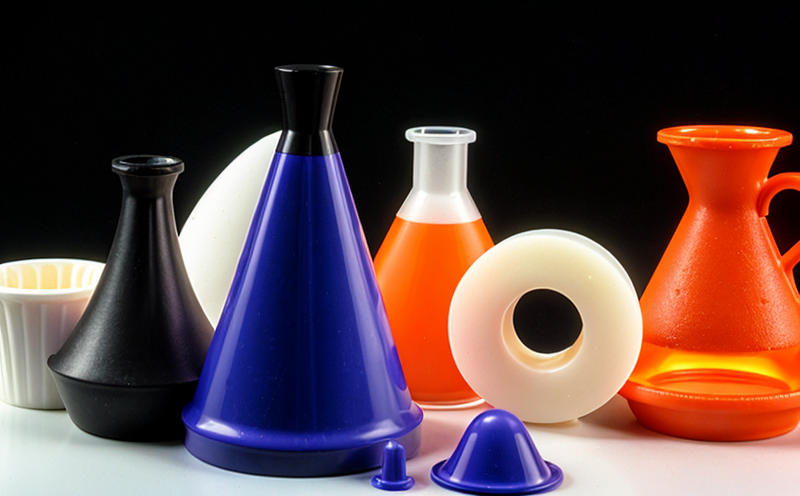Antistatic Additive Testing in Polymers
The testing of antistatic additives within polymers is crucial for ensuring that materials exhibit the desired level of electrical conductivity to prevent static build-up. Static electricity can lead to significant issues, including product damage, safety hazards, and operational inefficiencies, particularly in industries like electronics, pharmaceuticals, and textiles.
Antistatic additives are compounds added during the polymerization or processing stages to enhance the surface conductivity of polymers. These additives help dissipate static charge by promoting the flow of electrons on the material’s surface. Accurate testing is essential to ensure that these additives are effectively dispersing throughout the polymer matrix, enhancing its electrical properties as intended.
Our laboratory uses advanced analytical techniques to conduct comprehensive antistatic additive testing in polymers. The process begins with precise sample preparation, where we ensure that the polymer samples are representative of the production batch. This step is critical for obtaining accurate results that reflect real-world performance conditions.
The testing methodologies employed include differential scanning calorimetry (DSC) to assess the thermal behavior and crystallinity of the polymers, Fourier transform infrared spectroscopy (FTIR) to identify the presence of specific functional groups in the additives, and conductivity measurements using probes designed for different polymer types. These techniques allow us to evaluate not only the additive content but also its distribution within the polymer matrix.
A key aspect of our testing is ensuring that the additives are evenly dispersed throughout the material. Poor dispersion can lead to inconsistent antistatic properties, which may result in localized areas where static electricity accumulates. Our state-of-the-art equipment allows us to visualize and quantify this dispersion through advanced microscopy techniques such as scanning electron microscopy (SEM) and transmission electron microscopy (TEM).
The acceptance criteria for our testing are based on industry standards such as ASTM D2576, which specifies the procedure for determining the electrical resistivity of solid insulating materials. Compliance with these standards is essential to ensure that the tested polymers meet the required specifications for their intended applications.
Our team of experienced chemists and engineers works closely with clients to understand their specific requirements and tailor our testing protocols accordingly. This collaborative approach ensures that we provide accurate, reliable results that are directly applicable to your product development or quality assurance processes.
By leveraging these advanced testing methods, we can help you optimize the performance of antistatic additives in polymers, ensuring that they meet both regulatory requirements and customer expectations. Our detailed reports not only document the test results but also provide insights into potential improvements for future formulations.
Scope and Methodology
The scope of our antistatic additive testing encompasses a wide range of polymer types, including thermoplastics, elastomers, and engineering plastics. Our methodology is designed to cover various aspects of the testing process, from sample preparation to final reporting.
- Sample Preparation: We ensure that each sample is representative of the production batch by carefully cutting or grinding it into uniform pieces.
- Thermal Analysis: Differential scanning calorimetry (DSC) is used to assess the thermal stability and crystallinity of the polymers, which can affect how additives interact with them.
- Infrared Spectroscopy: Fourier transform infrared spectroscopy (FTIR) helps identify the presence of specific functional groups in the additives, ensuring compatibility with the polymer matrix.
- Electrical Conductivity Measurement: We use conductivity probes tailored to different polymer types to measure the electrical properties of the material after additive incorporation.
- Microscopy: Scanning electron microscopy (SEM) and transmission electron microscopy (TEM) are employed to visualize the distribution of additives within the polymer matrix, ensuring uniform dispersion.
The testing process is designed to comply with international standards such as ASTM D2576 for electrical resistivity, which ensures that our results are consistent and reliable. Our laboratory adheres strictly to these standards to provide accurate and compliant reports.
Use Cases and Application Examples
The testing of antistatic additives in polymers is essential across various industries. For instance, in the electronics sector, ensuring that circuit boards do not accumulate static electricity during manufacturing can prevent costly damage to components and enhance product reliability.
In pharmaceutical packaging, antistatic properties are crucial to protect sensitive medications from potential contamination due to electrostatic discharge. Our testing ensures that these materials meet stringent quality standards.
For textiles, the ability of polymers to dissipate static electricity improves wearer comfort and reduces the risk of fires in flammable environments. Our comprehensive tests help textile manufacturers achieve optimal performance without compromising safety.
In the automotive industry, antistatic properties are vital for preventing electrical shorts and ensuring that components can withstand harsh environmental conditions. Our laboratory provides testing services to meet these demanding requirements.
Our detailed reports provide valuable insights into how additives perform in different environments and under various processing conditions. This information is invaluable for R&D teams looking to innovate or troubleshoot existing formulations.





